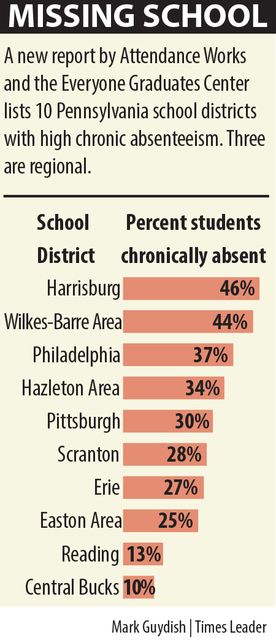Click here to subscribe today or Login.
In Wilkes-Barre Area and Hazleton Area School Districts, more than 6,000 students were absent at least 15 days in the 2013-14 school year, making them a big part of a national “chronic absenteeism” problem, according to a new report.
Using federal data, the report determined half of the nation’s chronically absent students attend just 4 percent of public school districts, with 10 of those districts in Pennsylvania. Of those 10, three are in this region: Hazleton Area, Wilkes-Barre Area and Scranton City.
Of the three, Wilkes-Barre area had the worst chronic absenteeism rate, with 44 percent of total enrollment missing 15 days or more. In Hazleton Area, 34.5 percent of students were chronically absent, and in Scranton City it was 28 percent.
By enrollment, Hazleton Area is the largest of the three, so even though it has a lower rate than Wilkes-Barre Area, it had more chronically absent students: 3,304 compared to Wilkes-Barre’s 3,000. Scranton had 2,680.
The report was issued jointly by Attendance Works and the Everyone Graduates Center. Titled “Preventing Missed Opportunity: Taking collective action to confront chronic absence,” it argues there is scant difference between excused and unexcused absences.
According to the report, studies show that missing just 10 percent or more of school — 18 days in a 180-day school year in Pennsylvania — increases odds of lower literacy, class failure, suspensions and dropping out.
The report stresses combating chronic absenteeism requires “a community-wide effort,” including the collection of accurate data that can be used to identify problems and programs.
Wilkes-Barre Area Director of Administration and Student Services Rochelle Koury said the district is doing just that.
“We’re finding chronic absenteeism is mostly a result of family issues,” Koury said. So in the last few years, the district has kept closer track of absences and takes quicker action.
“If a student is absent, we try to be very preventive,” she said. A single absence prompts at least a note or call to the family, just to make sure they know. “If they are absent three times, we send a legal notice to the parents. If it continues after that, we bring the parent or guardian in and try to form a connection with them.”
Getting family input can help figure out the cause behind the absences and what resources may help resolve the problems. The district recently updated its “truancy elimination plan” and renamed it “Student assistance and intervention program.”
“That’s something we’ve had a lot of success with,” Koury said. The district partners with other agencies to provide any support a family may need, including financial counseling, access to available aid, help with addiction and parenting lessons.
Noting the data used in the report is two years old, Koury said, “Since then, we’ve been doing a lot to get those numbers down.” Home visitor staff and others, including Solicitor Ray Wendolowski, now meet at least twice a month to look over data and address issues.
The district is also making final tweaks to a new attendance policy.
“The new policy is stricter,” Koury said. “We have more interventions put in place, we shorten the days required before we meet with parents, we shorten the days a student can be absent before they are barred from participating in some school activities.”
Wendolowski said success in reducing truancy and absenteeism is one of the most rewarding parts of his job. One of the changes was to get other agencies like Luzerne County Children and Youth involved earlier with a family to resolve issues.
“It’s not just kids choosing not to come to school,” Wendolowski said. “You have kids and families who need help, and we’re all about trying to get them the help they need.”
Absenteeism is a problem for all districts, Wendolowski said — a contention the report also makes — and changes countywide have contributed to the solutions.
Wendolowski thanked County Judge Jennifer Rogers, who handles many of the juvenile cases, for taking time to work with the families.
He also cited the County’s Court Appointed Special Advocate program, which trains volunteers to help advocate for children, and the county’s Bridge Youth Program as key partners in resolving family issues that underlie absenteeism.
“Truancy is a symptom,” Wendolowski said. “Half the time we find it isn’t related to school. We have to get the family into the process and figure out the cause. We have to let them know they don’t need to be afraid to ask for help.”






